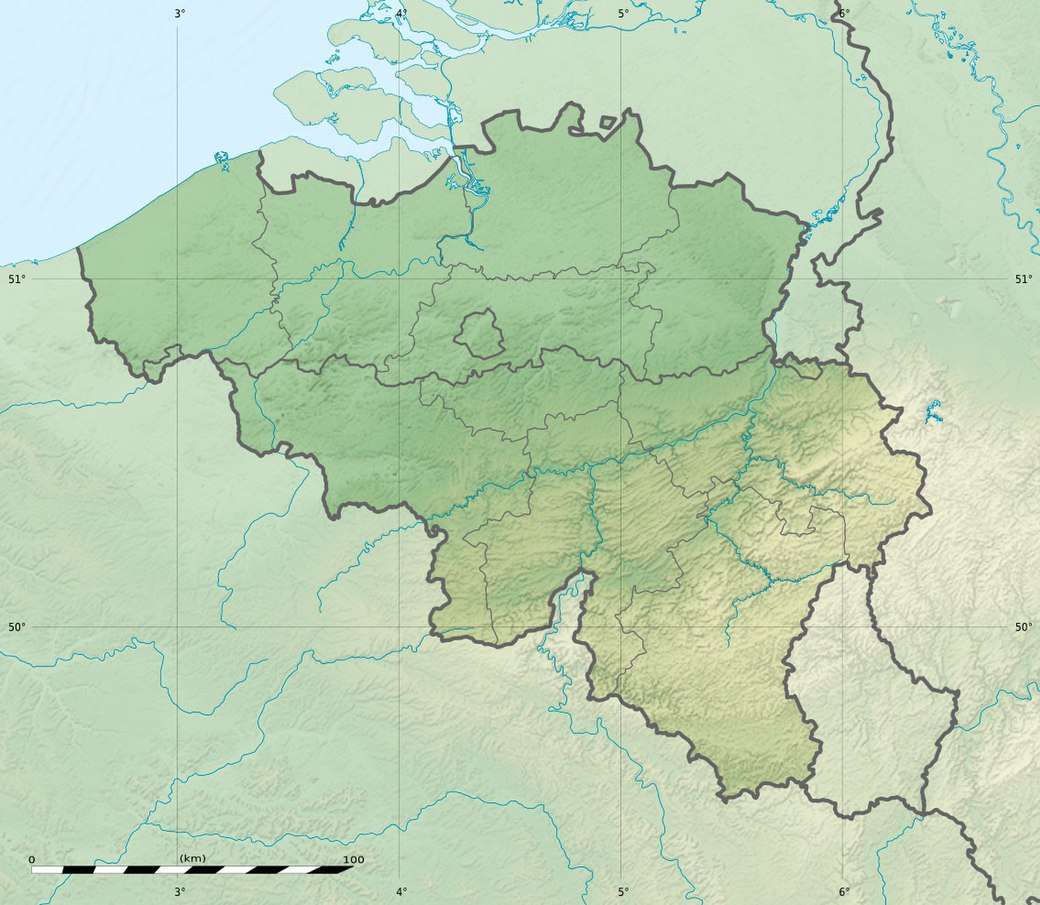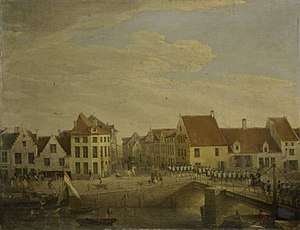Barrier Treaty
The "Barrier Treaties" (Dutch: Barrièretraktaat, Barrièreverdrag, French: traités de la Barrière) were a series of agreements signed and ratified between 1709 and 1715 that created a buffer zone between the Dutch Republic and Kingdom of France by allowing the Dutch to occupy a number of fortresses within the Spanish or Austrian Netherlands. The fortresses ultimately proved ineffective as a means of defence and the treaties were cancelled by Austria in 1781.
| Signed |
|
|---|---|
| Effective | 15 November 1715 |
| Condition | In order to help defend against French invasion, Dutch troops occupy fortresses within the Austrian Netherlands and share the costs with Austria. |
| Expiration | 1781 |
| Signatories |

Background
Between 1672-1697, a series of wars with France demonstrated the Dutch Republic's vulnerability to invasion via the Spanish Netherlands, leading to debate on how to design fortifications effective in the flat terrain of the Netherlands and where to locate them.[1] This resulted in the concept of forward defence or so-called 'Barrier Fortresses' in the Spanish Netherlands to provide 'strategic depth'.[2]
It was accepted that no fortified place could hold out indefinitely; the Republic was nearly over-run in 1672 by the speed with which the French captured major fortresses like Maastricht, and was saved only by flooding.[3] The Barrier was intended to slow down an attacking army and allow the Dutch time to reinforce their defences without the expense of a large standing army.[4]
The 1697 Treaty of Ryswick permitted the Dutch to garrison a number of cities, including Namur and Ypres, but in February 1701, the French quickly occupied these.[5] Re-establishing the Barrier was the primary Dutch objective during the War of the Spanish Succession, specified in Article 5 of the 1701 Treaty of the Hague that reformed the Grand Alliance. The Barrier also had an economic element, since the 1648 Peace of Münster gave the Dutch a monopoly over the Scheldt, making its extent a matter of debate, particularly with Britain. The Scheldt estuary was a key transportation point for European import and export; its control was a valuable commercial asset and allowed the merchants of Amsterdam to severely undermine the trade of their commercial rival Antwerp.[6]
The First Treaty; 1709
The first Treaty was signed on 29 October 1709 between Britain and the States-General and was primarily driven by the need to keep the Dutch in the War of the Spanish Succession. In return for Dutch support of the Protestant succession and a commitment to continuing the war, Britain agreed to a Barrier that effectively gave the Dutch permanent control of the Spanish Netherlands. It included Nieuwpoort, Ypres, Menen, Lille, Tournai, Valenciennes, Maubeuge, Charleroi, and Namur. The terms were seen as overly generous by British commercial interests since they included ports in Northern Flanders like Dendermonde and Ghent that controlled trade along the Scheldt, rather than blocking potential invasion routes.[7]
The Second Treaty; 1713
The 1710 British General election replaced the existing Whig government with a Tory administration that derived much of its support from the powerful City of London merchants guild. This led to demands for greater protection of British commercial access and the removal of Ostend and Dendermonde from the list.[8] A revised version was signed on 29 January 1713, which reduced the number of Barrier fortresses to 15, an in which Britain agreed to ensure compliance from the future ruler of the Spanish Netherlands.[9]
The Third Treaty; 1715

The third and final Barrier Treaty confirmed terms contained in the 1714 Treaty of Rastatt between Austria and France. This established a permanent Austro-Dutch military force of 30,000 to 35,000 men stationed in the Austrian Netherlands, the Dutch paying 40% of the costs and Austria 60% plus an additional lump sum to maintain the Barrier and its garrisons, now reduced to seven plus a mixed garrison at Dendermond. It also renewed the 1648 Münster agreement over the Scheldt but promised 'equal treatment' for Dutch and British commerce. The Treaty was signed on 15 November 1715, then further detailed by two Austrian-Dutch agreements of 30 and 31 January 1716.[lower-alpha 1][10]
Aftermath
The Dutch Republic ended the war in 1713 effectively bankrupt and the protection that cost them so much proved illusory. The Austrians were reluctant to pay for fortresses they did not control, and the fortresses were quickly overrun when the War of the Austrian Succession began in 1740. After Austria allied with France in 1756, the Barrier became irrelevant; in 1781 the Treaty was declared void by Emperor Joseph II.
However, the forts themselves were only part of the Dutch defence system; political and diplomatic treaties were far more important, particularly since Britain could not allow a hostile power to control ports in Northern Flanders like Ostend.[11] Britain's agreement to act as Guarantor of the Treaty and provide the Dutch with military support against any aggressor ultimately proved to be far more effective than the Barrier itself.[12] Nevertheless, during the French Revolutionary Wars, French forces invaded and overran the Dutch Republic, establishing the Batavian Republic. The Netherlands remained directly or indirectly under French control for nearly two decades.
After Napoleon's defeat in 1815, the Netherlands united with the former Austrian Netherlands and Prince Bishopric of Liège to become the United Kingdom of the Netherlands. A stronger and more complex Barrier was constructed along the new Netherlands/France border, supervised by Wellington; this program was largely complete by 1820 but the fortresses became part of Belgium following its independence in 1830.[13]
Notes
- Emperor Charles VI and Frederick William I of Prussia also ceded several cities in the Upper Guelders region to the United Provinces.
References
- Duffy, Christopher (1985). The Fortress in the Age of Vauban and Frederick the Great 1660-1789 (2017 ed.). Routledge. p. 35. ISBN 1138924644.
- Khan, Kalid Masood (October 16, 2015). "The Strategic Depth Concept". The Nation. Retrieved 4 May 2018.
- Lynn, John (1999). The Wars of Louis XIV, 1667–1714. Modern Wars In Perspective. Longman. p. 117. ISBN 0582056292.
- Afflerbach, Holger; Strachan, Hew, eds. (2012). How Fighting Ends: A History of Surrender. Oxford University Press. p. 159. ISBN 0199693625.
- Thompson, R. H. (1973). Lothar Franz von Schönborn and the diplomacy of the Electorate of Mainz, from the Treaty of Ryswick to the outbreak of the War of the Spanish Succession. Springer. p. 157. ISBN 9024713463.
- Lesaffer, Randall (February 2016). "Fortress Belgium – The 1715 Barrier Treaty". Oxford Public & International Law. Retrieved 2 May 2018.
- Nolan, Cathal (2008). Wars of the Age of Louis XIV, 1650-1715: An Encyclopedia of Global Warfare and Civilization. Greenwood. p. 37. ISBN 0313330468.
- Lesaffer, Randall (February 2016). "Fortress Belgium – The 1715 Barrier Treaty". Oxford Public & International Law. Retrieved 2 May 2018.
- Nolan, Cathal (2008). Wars of the Age of Louis XIV, 1650-1715: An Encyclopedia of Global Warfare and Civilization. Greenwood. p. 37. ISBN 0313330468.
- Myers (1917). "Violation of Treaties: Bad Faith, Nonexecution and Disregard". The American Journal of International Law. 11 (4): 799-829 passim.
- Kubben, Raymond (2011). Regeneration and Hegemony; Franco-Batavian Relations in the Revolutionary Era 1795-1803. Martinus Nijhoff. p. 148. ISBN 9004185585.
- Ward, Adolphus William (1922). The Cambridge History of British Foreign Policy, Volume 2 (2011 ed.). Cambridge University Press. p. 57. ISBN 1108040136.
- Veve, Thomas Dwight (1992). The Duke of Wellington and the British Army of Occupation in France, 1815-1818. Greenwood Press. pp. 93–108. ISBN 0313279411.
Sources
- Afflerbach, Holger and Strachan, Hew (ed); How Fighting Ends: A History of Surrender. (OUP, 2012)
- Kubben, Raymond; Regeneration and Hegemony; Franco-Batavian Relations in the Revolutionary Era 1795-1803. (Martinus Nijhoff, 2011);
- Low,John and Pulling, F.S.; The Dictionary of English History; (Cassell, 1910);
- Myers, Denys; Violation of Treaties: Bad Faith, Nonexecution and Disregard (American Journal of International Law, 1917);
- Nolan, Cathal; Wars of the Age of Louis XIV, 1650-1715: An Encyclopedia of Global Warfare and Civilization (Greenwood, 2008);
- Veve, Thomas Dwight; The Duke of Wellington and the British Army of Occupation in France, 1815-1818. (Greenwood, 1992).